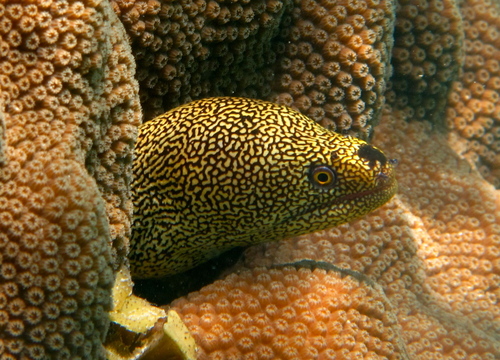
Goldentail Moray
The Atlantic Bluefin Tuna (Thunnus thynnus) is a highly migratory, large pelagic fish known for its incredible speed, size, and commercial value. It plays a critical role in the marine ecosystem. This species is a marvel of evolution, adapted for long-distance travel and predatory efficiency.
5 18 years
Lifespan
70 cm
Length
Least Concern
Conservation Status
null km/h
Swimming speed
Carnivorous
Diet
Local Migration
Migration
Appearance Overview
The Atlantic Bluefin Tuna is renowned for its large, streamlined body, built for speed and endurance.
Coloration
Dark metallic blue above, silvery white below
Fins
Two dorsal fins, the first depressible; short pectoral fins
Body Shape
Torpedo-shaped, designed for efficient swimming
Length
Commonly up to 6.5 feet (2 meters), maximum up to 10 feet (3 meters)
Weight
Commonly up to 550 lbs (250 kg), maximum up to 1,500 lbs (680 kg)
Diet
Carnivorous, feeding on a variety of fish, squid, crustaceans, and eels
Feeding Behavior
An opportunistic predator, the Bluefin Tuna uses its speed and agility to hunt, often feeding near the surface but also diving deep
Social Behavior
Forms large schools, especially during migration and spawning; exhibits complex social behaviors
Commercial Relevance
Extremely high value in the global seafood market, especially for sushi and sashimi; one of the most expensive fish species
Conservation measures
International fishing quotas, catch limits, monitoring programs, and efforts to reduce illegal fishing
Status
Endangered (varies by population segment; some are critically endangered)
Threats
Severe overfishing driven by high demand, bycatch in other fisheries, habitat degradation, and climate change affecting prey availability
Habitat Distribution
Depth Range
Surface waters to depths of over 3,000 feet (900 meters)
Geographic Range
Western and Eastern Atlantic Ocean, Mediterranean Sea
Preferred Environment
Pelagic, open ocean; prefers temperate waters but can tolerate a wide range of temperatures
Reproduction and Life Cycle
Breeding Habits
Spawns in warm waters, with major spawning grounds in the Gulf of Mexico and the Mediterranean Sea; spawning occurs in spring and summer
Development Stages
Eggs hatch into larvae, which develop rapidly in nutrient-rich waters; juveniles grow quickly, migrating and schooling with others
Fecundity
Highly fecund; females can produce up to 30 million eggs per season, depending on their size and health
Maturity Age
Reaches sexual maturity at around 4-8 years, though this can vary by location
Faqs about Goldentail Moray
How long do Atlantic Bluefin Tuna live?
Atlantic Bluefin Tuna can live up to 40 years, with some individuals possibly living longer.
Where are Atlantic Bluefin Tuna found?
They are found in the Atlantic Ocean, from Newfoundland to the Gulf of Mexico in the west, and from Norway to the Mediterranean Sea in the east.
Can you fish for Atlantic Bluefin Tuna?
Yes, but due to their endangered status, fishing is highly regulated and restricted to specific quotas.
What do Atlantic Bluefin Tuna eat?
They primarily feed on smaller fish like herring and mackerel, as well as squid, crustaceans, and eels.
How many eggs do they lay?
Females can release millions of eggs per spawning season, with numbers varying based on size and condition.
When do Atlantic Bluefin Tuna reach maturity?
They reach maturity around 4-8 years of age, depending on their location and environmental conditions.
Are Atlantic Bluefin Tuna warm-blooded?
They are warm-blooded, allowing them to maintain a higher body temperature than the surrounding water, which aids in their swimming speed and endurance.
What are the predators of Atlantic Bluefin Tuna?
They are apex predators with few natural predators besides orcas, sharks, and humans.
Copyright @ Nature Style Limited. All Rights Reserved.
 English
English